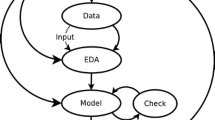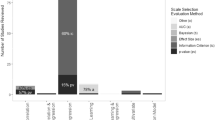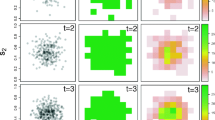Abstract
An important objective of experimental biology is the quantification of the relationship between sets of predictor and response variables, a statistical analysis often termed variance partitioning (VP). In this paper, a series of simulations is presented, aiming to generate quantitative estimates of the expected statistical uncertainty of VP analyses. We demonstrate scenarios with considerable uncertainty in VP estimates, which can significantly reduce the statistical reliability of the obtained results. Especially when a predictor variable of a dataset shows a low variance between the sampled sites, VP estimates may show a high margin of error. This becomes particularly important when the respective predictor variable only explains a small fraction of the overall variance, or the number of replicates is particularly small. Moreover, it is demonstrated that the expected error of VP estimates of a dataset can be approximated, and that accurate confidence intervals of the estimates can be obtained by bootstrap resampling, giving researchers a tool for the quantification of the uncertainty associated with an arbitrary VP analysis. The applicability of this method is demonstrated by a re-analysis of the Oribatid mite dataset introduced by Borcard and Legendre in 1994 and the Barro Colorado Island tree count dataset by Condit and colleagues. We believe that this study may encourage biologists to approach routine statistical analyses such as VP more critically, and report the error associated with them more frequently.







Similar content being viewed by others
Data availability
The source code of all simulations, as well as all generated raw data are available in this repository: https://github.com/Matthias-M-Fischer/Variance-Partitioning-Paper. The two re-analysed datasets have already been published and are readily available.
References
Allouche O, Steinitz O, Rotem D, Rosenfeld A, Kadmon R (2008) Incorporating distance constraints into species distribution models. J Appl Ecol 45(2):599–609
Amici V, Santi E, Filibeck G, Diekmann M, Geri F, Landi S, Scoppola A, Chiarucci A (2013) Influence of secondary forest succession on plant diversity patterns in a mediterranean landscape. J Biogeogr 40(12):2335–2347
Austin M (1976) On non-linear species response models in ordination. Vegetatio 33(1):33–41
Bojková J, Schenková J, Horsák M, Hájek M (2011) Species richness and composition patterns of clitellate (Annelida) assemblages in the treeless spring fens: the effect of water chemistry and substrate. Hydrobiologia 667(1):159–171
Borcard D, Legendre P (1994) Environmental control and spatial structure in ecological communities: an example using oribatid mites (acari, oribatei). Environ Ecol Stat 1(1):37–61
Borcard D, Legendre P, Drapeau P (1992) Partialling out the spatial component of ecological variation. Ecology 73(3):1045–1055
Burrascano S, Sabatini F, Blasi C (2011) Testing indicators of sustainable forest management on understorey composition and diversity in southern Italy through variation partitioning. Plant Ecol 212(5):829–841
Chen Y (2013) A comparison of synonymous codon usage bias patterns in dna and rna virus genomes: quantifying the relative importance of mutational pressure and natural selection. BioMed Res Int. https://doi.org/10.1155/2013/406342
Condit R, Pitman N, Leigh EG, Chave J, Terborgh J, Foster RB, Núnez P, Aguilar S, Valencia R, Villa G et al (2002) Beta-diversity in tropical forest trees. Science 295(5555):666–669
Cottenie K (2005) Integrating environmental and spatial processes in ecological community dynamics. Ecol Lett 8(11):1175–1182
Dong X, Li B, He F, Gu Y, Sun M, Zhang H, Tan L, Xiao W, Liu S, Cai Q (2016) Flow directionality, mountain barriers and functional traits determine diatom metacommunity structuring of high mountain streams. Sci Rep 6:24711
Dou P, Cui B, Xie T, Dong D, Gu B (2016) Macrobenthos diversity response to hydrological connectivity gradient. Wetlands 36(1):45–55
Dray S, Pélissier R, Couteron P, Fortin M-J, Legendre P, Peres-Neto PR, Bellier E, Bivand R, Blanchet FG, De Cáceres M et al (2012) Community ecology in the age of multivariate multiscale spatial analysis. Ecol Monogr 82(3):257–275
Efron B (1979) Bootstrap methods: another look at the jackknife. Ann Stat 7(1):1–26
Efron B, Tibshirani R (1986) Bootstrap methods for standard errors, confidence intervals, and other measures of statistical accuracy. Stat Sci 1(1):54–75
Fried G, Kazakou E, Gaba S (2012) Trajectories of weed communities explained by traits associated with species’ response to management practices. Agric Ecosyst Environ 158:147–155
Fyllas NM, Patino S, Baker T, Bielefeld Nardoto G, Martinelli L, Quesada C, Paiva R, Schwarz M, Horna V, Mercado L et al (2009) Basin-wide variations in foliar properties of amazonian forest: phylogeny, soils and climate. Biogeosciences 6:2677–2708
Gilbert B, Bennett JR (2010) Partitioning variation in ecological communities: do the numbers add up? J Appl Ecol 47(5):1071–1082
Gobet A, Böer SI, Huse SM, Van Beusekom JE, Quince C, Sogin ML, Boetius A, Ramette A (2012) Diversity and dynamics of rare and of resident bacterial populations in coastal sands. ISME J 6(3):542
Heikkinen RK, Luoto M, Virkkala R, Rainio K (2004) Effects of habitat cover, landscape structure and spatial variables on the abundance of birds in an agricultural-forest mosaic. J Appl Ecol 41(5):824–835
Heikkinen RK, Luoto M, Kuussaari M, Pöyry J (2005) New insights into butterfly-environment relationships using partitioning methods. Proc R Soc Lond B Biol Sci 272(1577):2203–2210
Hill M, Tiedeman C (2006) Effective groundwater model calibration: with analysis of data, sensitivities, predictions, and uncertainty. Wiley, Hoboken
Hoffman GE, Schadt EE (2016) Variance partition: interpreting drivers of variation in complex gene expression studies. BMC Bioinform 17(1):483
Hutchinson G (1957) Population studies-animal ecology and demography-concluding remarks. In: Cold Spring Harbor symposia on quantitative biology, vol 22, pages 415–427. Cold Spring Harbor Lab Press, New York
Hyvönen T, Holopainen J, Tiainen J (2005) Detecting the spatial component of variation in the weed community at the farm scale with variation partitioning by canonical correspondence analysis. Weed Res 45(1):48–56
Legendre P, Mi X, Ren H, Ma K, Yu M, Sun I-F, He F (2009) Partitioning beta diversity in a subtropical broad-leaved forest of China. Ecology 90(3):663–674
Li J, Xu Q, Zheng Z, Lu H, Luo Y, Li Y, Li C, Seppä H (2015) Assessing the importance of climate variables for the spatial distribution of modern pollen data in China. Quat Res 83(2):287–297
Makarenkov V, Legendre P (2002) Nonlinear redundancy analysis and canonical correspondence analysis based on polynomial regression. Ecology 83(4):1146–1161
Minchin PR (1987) Simulation of multidimensional community patterns: towards a comprehensive model. Vegetatio 71(3):145–156
Morelli F, Benedetti Y, Su T, Zhou B, Moravec D, Šímová P, Liang W (2017) Taxonomic diversity, functional diversity and evolutionary uniqueness in bird communities of beijing’s urban parks: effects of land use and vegetation structure. Urban For Urban Green 23:84–92
Mykrä H, Heino J, Muotka T (2007) Scale-related patterns in the spatial and environmental components of stream macroinvertebrate assemblage variation. Glob Ecol Biogeogr 16(2):149–159
Oksanen J, Blanchet FG, Friendly M, Kindt R, Legendre P, McGlinn D, Minchin PR, O’Hara RB, Simpson GL, Solymos P, Stevens MHH, Szoecs E, Wagner H (2016) Vegan: community ecology package. R package version 2.4-0
Pelletier J, Codjia C, Potvin C (2012) Traditional shifting agriculture: tracking forest carbon stock and biodiversity through time in Western Panama. Glob Change Biol 18(12):3581–3595
Peres-Neto PR, Legendre P, Dray S, Borcard D (2006) Variation partitioning of species data matrices: estimation and comparison of fractions. Ecology 87(10):2614–2625
Sacchi R, Mangiacotti M, Scali S, Sannolo M, Zuffi MA, Pellitteri-Rosa D, Bellati A, Galeotti P, Fasola M (2015) Context-dependent expression of sexual dimorphism in island populations of the common wall lizard (Podarcis muralis). Biol J Linnean Soc 114(3):552–565
ter Braak C (1986) Canonical correspondence analysis: a new eigenvector technique for multivariate direct gradient analysis. Ecology 67(5):1167–1179
Wang Y, Yang J, Liu L, Yu Z (2015) Quantifying the effects of geographical and environmental factors on distribution of stream bacterioplankton within nature reserves of Fujian, China. Environ Sci Pollut Res 22(14):11010–11021
Wang X, Helgason B, Westbrook C, Bedard-Haughn A (2016) Effect of mineral sediments on carbon mineralization, organic matter composition and microbial community dynamics in a mountain Peatland. Soil Biol Biochem 103:16–27
Yang W, Zheng Y, Gao C, Duan J-C, Wang S-P, Guo L-D (2016) Arbuscular mycorrhizal fungal community composition affected by original elevation rather than translocation along an altitudinal gradient on the qinghai-tibet plateau. Sci Rep 6:36606
Acknowledgements
I would like to thank M.Sc. Joscha Reichert for his extensive and extremely helpful comments on an earlier version of the manuscript. I also would like to thank Dr. Stavros D. Veresoglou for providing the initial research question and his guidance and assistance throughout this research project. Finally, I am indebted to three anonymous peer reviewers who provided thoughtful and constructive feedback to an earlier version of this manuscript and greatly helped improving its quality.
Author information
Authors and Affiliations
Corresponding author
Additional information
Handling Editor: Bryan F. J. Manly.
Electronic supplementary material
Below is the link to the electronic supplementary material.
Fig. S1
Effect of the sample size n on the bias of the obtained VP estimates. Error bars represent the standard error of the mean across all simulated ten replicate analyses (PDF 218 KB)
Fig. S2
Influence of the sampling range width on the bias of the obtained VP estimates. Error bars represent the standard error of the mean across all ten simulated replicates (PDF 189 KB)
Fig. S3
Effects of the difference in optimal values in species response curves on the bias of the obtained VP estimates. Error bars represent the standard error of the mean across all ten simulated replicates (PDF 218 KB)
Rights and permissions
About this article
Cite this article
Fischer, M.M. Quantifying the uncertainty of variance partitioning estimates of ecological datasets. Environ Ecol Stat 26, 351–366 (2019). https://doi.org/10.1007/s10651-019-00431-6
Received:
Revised:
Published:
Issue Date:
DOI: https://doi.org/10.1007/s10651-019-00431-6




